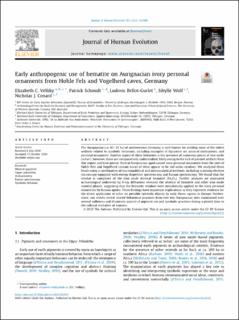| dc.contributor.author | Velliky, Elizabeth | |
| dc.contributor.author | Schmidt, Patrick | |
| dc.contributor.author | Ludovic, Bellot-Gurlet | |
| dc.contributor.author | Sibylle, Wolf | |
| dc.contributor.author | Conard, Nicholas J. | |
| dc.date.accessioned | 2021-05-03T13:24:16Z | |
| dc.date.available | 2021-05-03T13:24:16Z | |
| dc.date.created | 2020-11-30T09:31:59Z | |
| dc.date.issued | 2021 | |
| dc.identifier.issn | 0047-2484 | |
| dc.identifier.uri | https://hdl.handle.net/11250/2753319 | |
| dc.description.abstract | The Aurignacian (ca. 43–35 ka) of southwestern Germany is well known for yielding some of the oldest artifacts related to symbolic behaviors, including examples of figurative art, musical instruments, and personal ornaments. Another aspect of these behaviors is the presence of numerous pieces of iron oxide (ocher); however, these are comparatively understudied, likely owing to the lack of painted artifacts from this region and time period. Several Aurignacian-aged carved ivory personal ornaments from the sites of Hohle Fels and Vogelherd contain traces of what appear to be red ocher residues. We analyzed these beads using a combination of macroanalytical and microanalytical methods, including scanning electron microscopy equipped with energy dispersive spectroscopy and Raman spectroscopy. We found that the residue is composed of the iron oxide mineral hematite (Fe2O3). Further analyses on associated archaeological sediments by X-ray diffraction revealed the absence of hematite and other iron oxide mineral phases, suggesting that the hematite residues were intentionally applied to the ivory personal ornaments by human agents. These findings have important implications as they represent evidence for the direct application of ocher on portable symbolic objects by early Homo sapiens in Europe. Furthermore, our results reveal shared behavioral practices from two key Aurignacian sites maintained over several millennia and illuminate aspects of pigment use and symbolic practices during a pivotal time in the cultural evolution of humans. | en_US |
| dc.language.iso | eng | en_US |
| dc.publisher | Elsevier | en_US |
| dc.rights | Navngivelse 4.0 Internasjonal | * |
| dc.rights.uri | http://creativecommons.org/licenses/by/4.0/deed.no | * |
| dc.title | Early anthropogenic use of hematite on Aurignacian ivory personal ornaments from Hohle Fels and Vogelherd caves, Germany | en_US |
| dc.type | Journal article | en_US |
| dc.type | Peer reviewed | en_US |
| dc.description.version | publishedVersion | en_US |
| dc.rights.holder | Copyright 2020 The Authors | en_US |
| dc.source.articlenumber | 102900 | en_US |
| cristin.ispublished | true | |
| cristin.fulltext | original | |
| cristin.qualitycode | 1 | |
| dc.identifier.doi | https://doi.org/10.1016/j.jhevol.2020.102900 | |
| dc.identifier.cristin | 1853920 | |
| dc.source.journal | Journal of Human Evolution | en_US |
| dc.source.40 | 150 | |
| dc.source.14 | 2021 | |
| dc.identifier.citation | Journal of Human Evolution. 2021, 150, 102900 | en_US |
| dc.source.volume | 150 | en_US |

